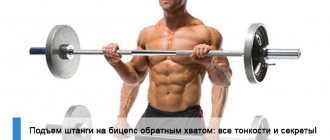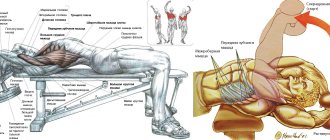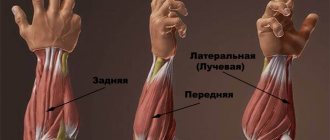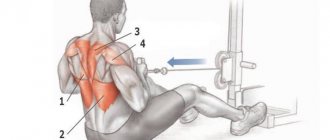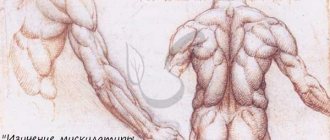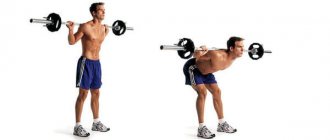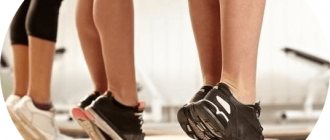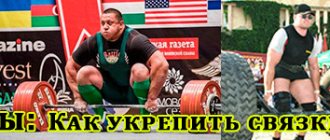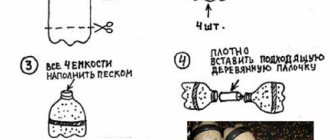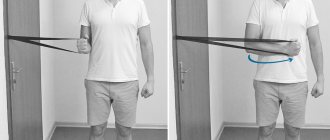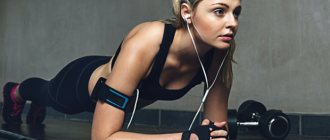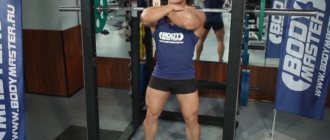With proper organization of the training process, the mandatory program of any type of fitness should include elements aimed at working out and strengthening the muscles responsible for the functioning of the shoulder joint. These exercises are important for achieving maximum and safe shoulder function. This is especially true for beginners who do not yet know how to adequately assess their capabilities and often treat the technique of performing elements and sports equipment carelessly, and as a result, injure the shoulder girdle during fitness training.
Exercise with dumbbells “Cuban press”
Such basic exercises include the “Cuban Press,” which should be an obligatory element of a high-quality and well-formed workout. But many beginners have no idea about such an effective training movement, and others do not attach importance to it, preferring more popular exercises with dumbbells.
The Cuban Press specifically targets the anterior and middle segments of the deltoid muscle. Also, this exercise simultaneously involves other groups of muscle tissue:
- trapezius muscles;
- small heads of biceps muscles;
- torso muscles;
- rotator cuff - a group of muscle tissue located near the shoulder joint. It is responsible for its functioning, in particular, for the ability to perform rotational movements of the joint.
It is rotator cuff training that allows you to minimize shoulder injuries during fitness classes.
The body position during this training movement can be “standing” or “sitting” on a sports bench. Some athletes, taking as an example the fitness training of Arnold Schwarzenegger, who did the “Cuban press” on a bench with a vertical back, perform it in the same way: sitting, pressing the lower back, shoulder blades and the back of the head to the back of the bench. Performing this exercise in a sitting position is easier, since the trainee does not spend additional strength on maintaining balance, so this option is more suitable for beginners.
The Cuban press consists of several movements performed in a clear sequence:
- Firmly fix the dumbbells with a straight grip, while extending the upper limbs along the body.
- Immediately bend your arms and spread them apart so that the parts of your arms from the elbow to the collarbone are parallel to the floor. In this case, it is necessary to maintain right angles in the bends of the elbows and between the body and the arm in the armpit.
- Then you need to make a rotational movement using the rotator cuff muscles so that the dumbbells end up approximately at the level of the temporal part of the head (maintaining right angles in the elbow bends).
- From the previous position, it is necessary to perform a standard press with your arms up, firmly holding the implements and maintaining a parallel position of your arms. Depending on your level of physical fitness, beginners may not need to perform this step at first. And to increase the load, you can add intensity and squeeze the shells up at a higher speed.
- Returning to the starting position involves performing the exercise with dumbbells in the reverse order.
Although in the classic version this exercise is performed with dumbbells, it is also possible to use a barbell or any other object that acts as a weighting agent if the training takes place at home.
If work is carried out with a barbell, it should be light in weight. You should pull it up to your chin, then smoothly place the bar on your palm and from this position press the barbell above your head.
An important nuance of this fitness element is the correct and adequate selection of working weight, which the muscles of the shoulder girdle can handle at a specific level of physical fitness.
Technical errors include:
- incorrectly selected weight of shells;
- violation of the concept and algorithm for executing an element;
- non-compliance with rhythm and tempo while performing exercises with dumbbells.
How can you replace the Cuban press?
You can replace the activity with any loads that strengthen the muscles and joints of the shoulder girdle.
You can experiment with different variations of this task:
- Bench press – here it is easier to control the position of your hands. It is important not to use your core and leg muscles;
- Bent over press – when the torso is tilted 45 degrees forward, the load shifts to the rear deltoids. The back should be straight to eliminate the possibility of spinal injuries;
- Bench press on an incline bench - in the proposed version, the load on the back is eliminated. Otherwise, the work proceeds similarly to the previous methods;
- seated press - if you still move your body when performing a standing bogey, then you need to sit on a sports bench and work on it. This way you will no longer be able to help yourself with your torso, and the load on your arms will be greater.
Rules for performing the fitness exercise “Cuban Press”
Technically correct execution is the key to the effectiveness of the Cuban Press. But to achieve the desired results, all the nuances are important, so during fitness training you should take into account some recommendations:
- The number of repetitions should be selected individually based on the factor in which quality does not suffer at the expense of quantity. In other words, you can perform the exercise as many times as possible without compromising proper technique. Typically, the optimal number is from one to two dozen presses in one approach, depending on the athlete’s level of training.
- All stages of movements at any working weight should be performed smoothly. The only exception with a slight acceleration can be the last stage - the overhead press from the shoulders.
- The body should be motionless, the chin directed forward, and the arms should maintain right angles at the elbows and between the forearm and the body. The rotation element is performed only by the muscles of the shoulder joint, without the help of others.
- It is strictly not recommended to do the Cuban Press with heavy weight. This exercise should be used as a preparatory exercise before performing strength and more intense training movements.
A few simple tips can make fitness training using the Cuban Press as effective as possible and speed up the appearance of the first results:
- the technique of performing an element must be approached as seriously and responsibly as possible;
- The “Cuban press” is not intended to increase muscle mass, but with its help you can form a beautiful muscle relief;
- you need to try to work in front of a mirror in order to be able to control the symmetry of movements and the correct functioning of the upper limbs;
- it is important to perform the “Cubic Press” regularly as a preparatory element or warm-up before the main fitness session;
- you need to select the weight individually, based on your own feelings;
- You should not perform this exercise with dumbbells if you have aching pain in the shoulder girdle.
Every athlete needs to strengthen their joints, especially the most mobile ones, which are the shoulders. To properly work out the shoulder girdle and strengthen the joints, it is recommended to perform such an unpopular exercise as the Cuban press with dumbbells. Although it is basic, its inclusion in the training program is quite rare for most athletes. And few people know about the existence of such a shoulder pumping technique. Due to the specific movements, the Cuban press has another funny name - the scarecrow exercise with dumbbells. Only the bogey is performed without the upward press.
Among all human joints, the shoulder is considered the most mobile and is often subject to injury. Every experienced weightlifter will tell you that the shoulder is the easiest to injure. After all, it is involved in a large number of exercises and often receives enormous loads. Naturally, in this mode, even with the correct technique, sooner or later you will have to face joint problems.
Therefore, you need to do a standing Cuban press with dumbbells, which will help strengthen the muscles of the shoulder girdle, make the ligaments elastic and strong, and work out the relief. All this will help avoid injury during heavy exercise.
Muscle work in the Cuban press
Of all the deltoid muscle bundles, only the anterior and middle ones are fully involved. Also included in the work:
- Trapezius muscles;
- Large/small pectorals;
- Short head of biceps;
- Back and abs as stabilizers.
Separately, it is necessary to note another important anatomical element of the shoulder girdle - the rotator cuff. It is a small muscular connection of the infraspinatus, supraspinatus, teres and subscapularis muscles. And it is responsible for a very serious mechanical function - rotation in the joints in any direction. Since we perform a large number of rotational movements in everyday life, you must understand how important these muscles are.
It turns out that doing the Cuban press, or as it is also called, the scarecrow with dumbbells, trains not only the deltoids, but also the rotator cuff. This will significantly reduce the chance of injury. If you damage the cuff, you will experience serious pain, and you will also have to stop training until it fully recovers. Train not only your muscles, but also your ligaments!
If you have had shoulder joint injuries in the past, or if you feel discomfort or pain during training, you should stop doing it and consult a doctor.
Cuban press with dumbbells: technique
You can perform this exercise with both dumbbells and a barbell. If this is your first acquaintance, then start with dumbbells, it will be easier to practice the correct execution:
- Warm up well and take an even position. Take the shells with a normal grip, placing your hands wider than shoulder-width apart;
- When lifting, your forearms should be perpendicular to the floor, the area from the elbow to the shoulder should be parallel to the floor, and a right angle should form at the elbows,
- Maintaining the position of your arms (right angle and parallel), lift the dumbbells in front of you along an arcuate path until your hands are vertical - this movement is called Cuban rotation. Only the shoulder joint should work;
- Now press the dumbbells up, straightening your arms. Hold the position for a second and return to a parallel position with your arms;
- We lower the dumbbells along a similar arc path, maintaining a right angle at the elbows. And then take a new approach;
- Do the required number of repetitions.
The movements of the Cuban press are the same movements of the scarecrow exercise with dumbbells, but plus an upward press. Thus, the deltas are loaded more heavily. If you need to load only the front deltoids, then use.
To increase execution efficiency, study these points:
- Working weight. To avoid injury, avoid large weights, use light weight equipment so that everything goes smoothly and painlessly;
- Movement speed. You should not move too quickly, especially when rotating a joint, even if you are light. Everything should be done at a moderate pace, only the bench press at the top mark can be done faster;
- Frame. From the very beginning to the end of the Cuban press, the abs and back muscles should be tense - this will allow you to maintain the natural position of the spine. The gaze is directed forward;
- Cheating. Any movements should be performed only through the efforts of the shoulder muscles. You cannot help with your body or legs. Better lose weight and do it right.
You can do bogeys with dumbbells while sitting on a bench, this way you will reduce the energy expended on maintaining balance.
To whom, when and how much
For whom: All athletes, because strengthening the rotator cuff is a task equally necessary for both experienced athletes and beginners. Moreover, the second thing, a scarecrow with dumbbells is especially useful, because their cuff is underdeveloped compared to the first;
When: Although the exercise is considered basic, it is not mass-gaining, so it is used to improve relief and strengthen ligaments. Performing the Cuban press with dumbbells is recommended at the end of shoulder training or at the start for warming up, so do it earlier;
How many: 12-18 repetitions, 3 sets.
Cuban press and scarecrow are exercises to strengthen the ligaments of the shoulder girdle and muscles. Using them in your program will increase your performance in pressing movements, as well as in other exercises where the shoulder joints are involved.
Masses and relief to you!
Among all the joints of the human body, the shoulder is the most mobile and the most frequently injured. Any experienced athlete who is fond of “heavy” sports will confirm that the easiest way to damage the shoulder is that it is involved in many exercises and often receives colossal loads. Naturally, even with the correct movement technique, this will sooner or later lead to problems with the joint.
In order to strengthen the joint and effectively work the deltoids, an exercise called the Cuban press is quite effective. Being basic, it is still quite rarely used in programs, and most beginners are not even aware of its existence. This is a serious omission, which we will now correct.
Anatomy
According to statistics, the shoulder joint is one of the most frequently injured in sports. This is the most mobile, but not the largest joint in our body. An important anatomical element of the shoulder is the rotator cuff. It is formed by several small muscles (supraspinatus, infraspinatus, subscapularis and teres) and allows us to rotate the shoulder in any direction.
Damage to this cuff causes serious pain and leads to the inability to play sports until recovery. Therefore, the task of each athlete is not only to train large muscles, but also to strengthen ligaments and small muscles.
The Cuban-style press, as well as its variation, which is jokingly called the dumbbell scarecrow, are excellent for achieving these goals.
The main working muscles in the exercise we are considering are the anterior and middle bundles of the deltoid muscles, as well as the trapezius. Since the movement consists of several successively changing phases (thrust, rotation, press), a lot of small muscles of the shoulder girdle are involved in its implementation. The role of position stabilizers is performed by the muscles of the arms, chest, back, and abs.
However, it is worth warning that if you already have injuries to the shoulder joints or pain or discomfort occurs during shoulder training, it is better to refrain from performing the exercise until you consult a doctor.
The weights used in the Cuban press or scarecrow are minimal - small dumbbells or a light barbell. The exercise, although basic, is not mass-gaining. It serves to work out the relief and strengthen the ligamentous apparatus. It can be performed after basic shoulder exercises or as a warm-up before training.
Cuban press
Working muscles
Of the three deltoid bundles, only two perform full-fledged work: the anterior and middle. In addition to them, a sufficient part of the work falls on:
- pectoralis major and minor muscles;
- short head of the humerus.
Special attention should be paid to the role of the rotator cuff in this exercise. Being a small muscle joint, the cuff is responsible for a fairly serious function - rotational movements in the joint. And since we perform them every day, including outside the gym, you can easily understand how great the importance of these muscles is.
By performing the Cuban press, we train not only the deltoids - an equally important aspect is the development of the cuff. By training this muscle group, you can significantly reduce the risk of injury.
To whom, when and why
As already mentioned, the movement is basic, therefore relevant for all athletes.
To whom?
Working out the rotator cuff is a task equally necessary for both professionals and beginners. For this reason, it is necessary for athletes of all levels to include the Cuban press in their program.
If in athletes with sufficient experience in sports, the rotator cuff is loaded when performing other exercises, then in beginners it is quite weak and is at increased risk of injury. For this reason, performing this exercise for beginners is especially useful.
When?
Despite the fact that this bench press is classified as a “basic” press, it is not considered serious and basic enough. On the day of working out the shoulder muscles, it is usually placed after more difficult exercises, like, or even included in the warm-up.
For what?
It should not be considered as an effective way to increase the volume of deltoids. Since using even a medium weight in the Cuban press is a rather dangerous undertaking, it is most often used to work out the relief (but for this it is excellent) and warm up/train the rotator cuff.
Cuban press technique
The exercise is performed either with a barbell or dumbbells. For a beginner, the first option is better - it’s easier to develop the right technique and move correctly.
- We take the weight in our hands (barbell or dumbbells - it doesn’t matter), and stand straight. We place our hands in such a way that a right angle is formed at the elbow joint, the forearm is perpendicular to the floor, and the area from the shoulder to the elbow is parallel. Palms point back.
- Performing rotation in the shoulder joint, we lift the barbell (dumbbells) along an arcuate path until the forearms are again perpendicular to the surface, only now the weight will be located above your head.
- Smoothly press the weight up, fully extending your arms.
- We lower the weight until the angle at the elbow joint becomes straight again and the forearm is perpendicular to the surface.
- We rotate the arm in the shoulder joint along an arcuate path downwards, returning the weight to its original position.
- We do the required number of repetitions.
- Working weight. Performing an exercise with maximum, or even average weight is the first step to injury. It is optimal to use minimal weights - they will allow you to move correctly and reduce danger.
- Number of repetitions. To effectively load the rotator cuff, it is necessary to perform many repetitions - optimally from 10 to 20 in 1 approach.
- Movement speed. Despite the use of minimal weight, it is not recommended to move too quickly (especially when rotating the arm in the joint). You can press the barbell up faster than when performing a regular bench press.
- Frame. Until the end of the exercise, the body should be motionless, the spine should maintain a natural curve, and the head should look straight.
- Elbow joint. During the first phase of the movement (rotation of the arm in the shoulder joint), the elbow joint should maintain a right angle.
- Hands. Mandatory nuance: at the beginning of the movement, the arm from shoulder to elbow must be parallel to the surface, and the forearm must be perpendicular to the floor.
- "Cheating." Rotation of the arm in the shoulder joint must be performed only by the force of the shoulder muscles - assistance from the body should be completely excluded. If you cannot avoid this, reduce weight.
- Alternatively, you can do the exercise while sitting on a bench - this will make it partly easier, since you will have to pay less attention to maintaining balance.
Strengthening the muscles that activate the shoulder joint is a mandatory measure for the competent organization of the training process in bodybuilding, fitness, gymnastics, swimming and other sports that involve achieving maximum functionality of the shoulder girdle.
This axiom is especially relevant for beginning athletes, since overestimating one’s capabilities can cause serious injuries that will not allow one to clearly demonstrate the perfection of one’s image and sportsmanship.
The “Cuban press” is an exercise that is a mandatory “ingredient” of a truly thoughtful and truly high-quality training for both beginners and professional athletes. Unfortunately, most beginners are not even aware of the existence of this exercise.
As a result, their motivation to achieve their goal quickly disappears, because careless handling of sports equipment will certainly lead to injuries to the shoulder joint - the most mobile functional element of the human musculoskeletal system.
That is why, in order to avoid the disastrous consequences of the desire to become strong and beautiful, it is necessary to clearly understand which muscles work when performing the “Cuban press”, as well as understand how to perform this exercise correctly.
Cuban press. What, why and why?
Agree, an unusual name for an exercise. Why they called him that, history is silent, but this, in fact, is not important. The important thing is that this exercise is rarely used by anyone in the gym. And today we will try to fix this. You can try it out at your next training session and make your own decision: will you use it or let it continue to “lie in the closet”. So, let's deal with our newbie.
Note: For better assimilation of the material, all further narration will be divided into subchapters.
Muscle atlas
The exercise belongs to the class of conditionally basic (compound) with a push/push type of force, and is aimed at working out the shoulders. The muscle ensemble includes the following units:
- primary – middle delta;
- secondary - trapezius, pectoral, triceps.
A complete muscle atlas looks like this:
Advantages
By performing the Cuban press exercise, you can expect to receive the following benefits:
- development of delta strength;
- improved shoulder stability;
- increasing mobility of the shoulder joint;
- strengthening the rotator cuff;
- reducing the risk of injury in bench press exercises.
Execution technique
The Cuban press is an exercise of medium difficulty level. The step-by-step execution technique is as follows:
Step #0.
Hold dumbbells of the desired weight in each hand with an overhand grip. Stand up straight with your feet shoulder-width apart. Static tense your abs, direct your gaze forward. This is your starting position.
Step #1.
Inhale and as you exhale, begin to pull the dumbbells toward your shoulders. Reach the bottom of your pecs and rotate your arms at the shoulder joint 180 degrees. Rotate until your wrists are directly above your elbows and your forearms are perpendicular to the floor. From that position, press the dumbbells upward, straightening your arms above your head. As you inhale, return to IP, performing the action in reverse order. Repeat the specified number of times.
In picture form it looks like this:
Variations
In addition to the standard version of the Cuban press, there are several variations of the exercise:
To get the most out of the exercise, follow these guidelines:
- do not make sudden jerking movements with your forearm;
- push the weight up from the tense shoulder;
- at the top point of the trajectory, do not fully extend your elbows;
- use adequate weights, increasing them as you progress;
- alternate the exercise with the option of sitting on a bench;
- when using heavy dumbbells, wear an athletic belt;
- breathing technique: inhale - when lowering the projectile down, exhale - when making a movement;
- numerical training parameters: number of approaches 3 , number of repetitions – 12-15 .
We're done with the theoretical side, now let's look at some practical points.
Cuban press - an effective shoulder exercise
Numerous studies on the electrical activity of muscles, in particular, American council exercise, 2018 (USA), place the dumbbell press exercise in the top 3 best for the shoulders. On the other hand, researchers from the journal Health Coach & Medical Exercise recommend including the Cuban press with dumbbells in your workouts as a preventive measure for shoulder injuries.
How to properly train your shoulders to avoid injury
The shoulder joint is a very complex and relatively fragile joint that can be easily injured. This is usually what happens when your shoulder training program contains only pressing exercises. The load on the deltoids comes not only in profile movements, such as the military press or dumbbell flyes. They also get their due in the bench press and push-ups.
Therefore, the correct shoulder training program should be formed based on different mechanics of movements. In other words, in addition to bench presses, PT should include rows and flyes. Exercises for the rotator cuff should stand apart. They must be performed before starting the main training program, with light weight for the number of repetitions. Do not neglect this rule, and your shoulders will serve you faithfully for many years.
Actually, that’s all for the content, let’s move on to.
What muscles does the Cuban press activate?
The lion's share of the work when performing this element of training is performed by the anterior as well as the middle bundle of the deltoid muscle.
At the same time, the following are pumped:
- short heads of the biceps brachii muscles;
- both trapezoids;
- small and large muscles of the thoracic segment of the torso.
A small set of muscles called the rotor cuff plays a vital role in ensuring optimal functioning of the shoulder joint.
It is this that guarantees full rotational movement in the shoulder joint. Therefore, by performing the “Cuban press,” the athlete trains not only the deltoid muscles, but also the rotator cuffs, which can practically eliminate the risk of shoulder girdle injuries.
Exercise options
Classic dumbbell press. In this case, the projectiles should be raised to the projection of the shoulders as simultaneously and smoothly as possible, fixing the elbows at the level of the auricle with a slight turn of the inner part of the wrist towards the chest.
This concept of training the shoulder girdle will allow you to correctly calculate the actual working weight that your muscles can handle, and will help prepare them for more complex exercises.
Light weight barbell press. When performing an exercise with this apparatus, the athlete should pull the bar up to his chin, then place it on his palms and press the barbell up.
True, the last element of the algorithm does not have to be executed. It all depends on the level of physical readiness of the muscular-ligamentous apparatus.
The exercise is performed sitting or standing. In the second case, you don’t have to spend unnecessary effort on maintaining balance in space, so it will be easier to perform the training element efficiently.
Execution technique
First of all, a person who wants to strengthen the shoulder girdle needs to master a simplified, safe exercise scheme.
From words to action! Stand up straight and hold the dumbbells in your arms at your sides. If possible, try to hide your thumbs in your palms. Such fixation of the projectiles will allow you to securely hold them even if you feel discomfort that occurs when untrained muscles are loaded.
When spreading your shoulders to the sides and simultaneously bending your arms at the elbows, try to raise them to a level where they become parallel to the plane of the floor. At the same time, lower your forearms down, trying to maintain a right angle of bend in the elbow joint.
The final element of the exercise is a standard press from the shoulders up. Returning to the starting position, the exercise algorithm should be performed in reverse order.
For competent, and most importantly, complete development of the rotor cuff, it is recommended to perform the maximum possible number of repetitions that the athlete can do without distorting the exercise technique. 10–20 repetitions are the best option for one approach.
The ideal number of repetitions would be when, after a set, a person feels pleasantly tired.
Movement speed
Even the small weight of the equipment when performing the “Cuban press” assumes the smoothness of all phases of this element of strength training.
Acceleration is possible only in the final phase, when the athlete squeezes the sports equipment above himself.
Body position
When rotating your arms in the shoulder joint, you must ensure that the elbow joints maintain right angles.
Hand position
When starting the movement, the arm segment from the shoulder to the elbow must certainly remain parallel to the floor, and the forearm must remain perpendicular to the surface.
When performing rotational movements of the arm in the shoulder joint, it is necessary to use only the muscle groups of the shoulder joint. In this case, any assistance from the core muscles is completely excluded.
Although such a press is a basic exercise when performing strength training in the gym, it is unacceptable to perform it with a large weight of equipment.
The Cuban Press should be considered as a preparatory exercise that will help perform more complex strength training tasks and insure the athlete against loss of functionality of the shoulder joint.
That is why the “Cuban press”, as a rule, is included in a comprehensive warm-up on the day of working out the muscles of the shoulder girdle or is performed after the main set of exercises.
By performing the Cuban press, you will not be able to significantly increase the volume of the deltoid muscle, but at the same time you will be able to effectively work out the relief of the shoulder girdle.
The main mistakes when performing the “Cuban press”
Incorrect selection of working weight of projectiles. The desire to demonstrate your strength in this exercise can lead to irreparable consequences that will not allow you to continue your sports career.
Failure to adhere to technology concepts. Failure to follow the rules for performing the exercise eliminates the opportunity to effectively strengthen and properly work out the relief of the muscles of the shoulder joint.
Violations of the rhythm and tempo of movements. This mistake is usually typical for beginners in strength sports.
Trying to perform the “Cuban press” as effectively as possible, they overestimate the capabilities of the rotor cuff, which leads to injury to the unprepared muscles of the shoulder girdle.
Agree, many of us admired the impeccably proportioned forms of Arnold Schwarzenegger. But few people know that one of the favorite exercises of the world-famous athlete was one of the variations of the “Cuban press.”
Understanding perfectly the physiological capabilities, as well as the anatomical features of the shoulder joint, the authority in bodybuilding and fitness regularly trained the muscle bundles of the rotor cuff. To do this, he preferred to perform the “Cuban press” with dumbbells while sitting.
Arnold Schwarzenegger's technique for performing the exercise was as follows. The athlete sat on a bench with a vertical back, pressing tightly against it with both the lower back, the upper segment of the back, and the back of the head.
As he inhaled, Arnold pressed the dumbbells and turned his forearms so that at the highest point the palms of his hands were facing forward.
While exhaling, the athlete performed the exercise algorithm in reverse order. The number of repetitions in the approaches corresponded to the onset of a feeling of pleasant fatigue, because he perfectly understood the inadmissibility of overloading the rotor cuffs of the shoulder girdle.
Recommendations
Number of repetitions
For competent, and most importantly, complete development of the rotor cuff, it is recommended to perform the maximum possible number of repetitions that the athlete can do without distorting the exercise technique. 10–20 repetitions are the best option for one approach.
The ideal number of repetitions would be when, after a set, a person feels pleasantly tired.
Movement speed
Even the small weight of the equipment when performing the “Cuban press” assumes the smoothness of all phases of this element of strength training.
Acceleration is possible only in the final phase, when the athlete squeezes the sports equipment above himself.
Body position
When doing the Cuban press, try to keep your torso static. The spinal column must maintain natural curves, and the chin must “look” straight ahead.
When rotating your arms in the shoulder joint, you must ensure that the elbow joints maintain right angles.
Hand position
When starting the movement, the arm segment from the shoulder to the elbow must certainly remain parallel to the floor, and the forearm must remain perpendicular to the surface.
When performing rotational movements of the arm in the shoulder joint, it is necessary to use only the muscle groups of the shoulder joint. In this case, any assistance from the core muscles is completely excluded.
Other tips
Although such a press is a basic exercise when performing strength training in the gym, it is unacceptable to perform it with a large weight of equipment.
The Cuban Press should be considered as a preparatory exercise that will help perform more complex strength training tasks and insure the athlete against loss of functionality of the shoulder joint.
That is why the “Cuban press”, as a rule, is included in a comprehensive warm-up on the day of working out the muscles of the shoulder girdle or is performed after the main set of exercises.
By performing the Cuban press, you will not be able to significantly increase the volume of the deltoid muscle, but at the same time you will be able to effectively work out the relief of the shoulder girdle.
The main mistakes when performing the “Cuban press”
Incorrect selection of working weight of projectiles. The desire to demonstrate your strength in this exercise can lead to irreparable consequences that will not allow you to continue your sports career.
Failure to adhere to technology concepts. Failure to follow the rules for performing the exercise eliminates the opportunity to effectively strengthen and properly work out the relief of the muscles of the shoulder joint.
Violations of the rhythm and tempo of movements. This mistake is usually typical for beginners in strength sports.
Trying to perform the “Cuban press” as effectively as possible, they overestimate the capabilities of the rotor cuff, which leads to injury to the unprepared muscles of the shoulder girdle.
